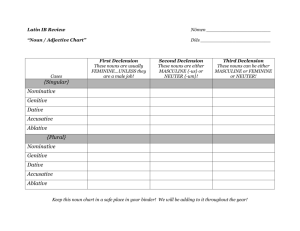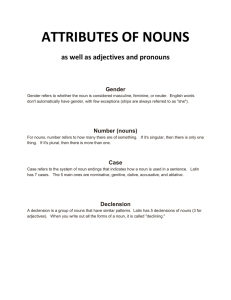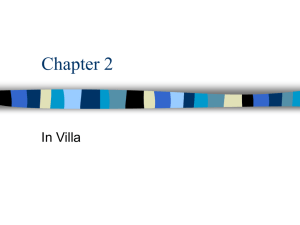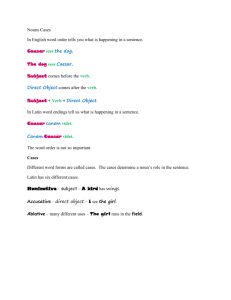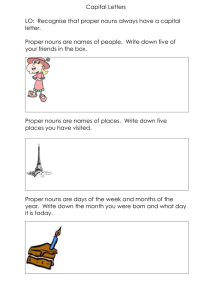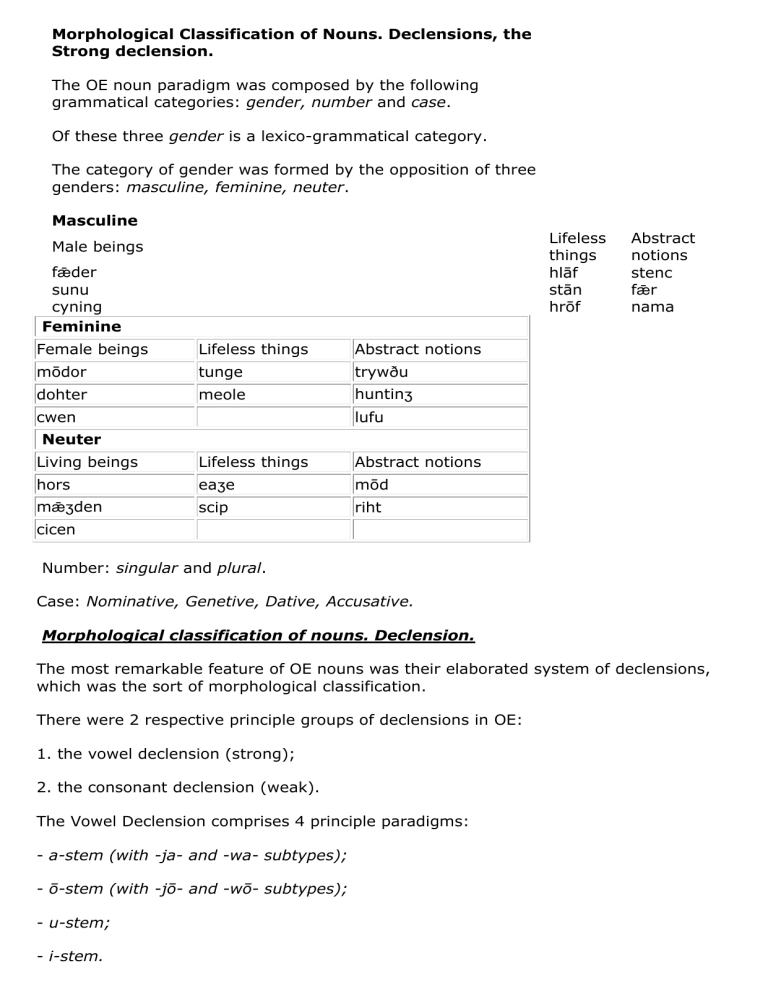
Morphological Classification of Nouns. Declensions, the Strong declension. The OE noun paradigm was composed by the following grammatical categories: gender, number and case. Of these three gender is a lexico-grammatical category. The category of gender was formed by the opposition of three genders: masculine, feminine, neuter. Masculine Lifeless things hlāf stān hrōf Male beings fǣder sunu cyning Feminine Female beings Lifeless things Abstract notions mōdor tunge trywðu dohter meole huntinʒ cwen Abstract notions stenc fǣr nama lufu Neuter Living beings Lifeless things Abstract notions hors eaʒe mōd mǣʒden scip riht cicen Number: singular and plural. Case: Nominative, Genetive, Dative, Accusative. Morphological classification of nouns. Declension. The most remarkable feature of OE nouns was their elaborated system of declensions, which was the sort of morphological classification. There were 2 respective principle groups of declensions in OE: 1. the vowel declension (strong); 2. the consonant declension (weak). The Vowel Declension comprises 4 principle paradigms: - a-stem (with -ja- and -wa- subtypes); - ō-stem (with -jō- and -wō- subtypes); - u-stem; - i-stem. The Consonant Declension comprises nouns with: - n-stem; - r-stem; - s-stem. In rare cases the new form was constructed adding the ending directly to the root. These words formed the so-called root-stem declension. Strong Declension . a-stems included Masc. and Neut. nouns. About 1/3 of OE nouns were Masc. a-stems, e. g. cniht (NE knight), ham (NE home); examples of Neut. nouns are: lim (NE limb), hus (NE house). Masculine A-stem Wa-stem singular plural singular Nominative stān stān-as bearu Genetive stān-es stān-a Dative stān-e Accusative stān plural bear-was bear-wes bear-wa stān-um bear-we bear-wum stān-as bearu bear-was Note should be taken of the inflections –es of the Gen. sg. and -as of the Nom. pl. Towards the end of the OE period they began to be added to an increasing number of nouns, which originally belonged to other stems. These inflections are the prototypes and sources of the ModE ‘s of the Possessive case and -(e)s markers of the plural. Neut. a-stems differed from Masc. in the plural of the Nom. and Acc. cases. Instead of as they took -u for short stems (that is nouns with a short root-syllable) and did not add any inflection in the long-stemmed variant. This peculiarity of Neut. a-stems goes back to some phonetic changes in final unaccented syllables which have given rise to an important grammatical feature: an instance of regular homonymy or neutralization of number distinctions in the noun paradigm. Neuter Short stem Long stem singular plural singular plural Nominative scip scip-u Genetive scip-es scip-a Dative scip-e Accusative scip þing þing þing-es þing-a scip-um þing-e þing-um scip-u þing þing O-stems o-stems were all Fem., so there was no further subdivision according to gender. The variants with -jo- and -wo- decline like pure o-stems except that -w- appears before some endings. The difference between short- and long-stemmed o-stems is similar to that between respective a-stems: after a short syllable the ending -u is retained, after a long syllable it is dropped. singular plural Nominative wund wund-a Genetive wund-e wund-a Dative wund-e wund-um Accusative wund-e wund-a The other vocalic stems, i-stems and u-stems, include nouns of different genders. Division into genders breaks up i-stems into three declensions. Comparison of the istems with a-stems reveals many similarities. It appears that Masc. i-stems adopted some forms from Masc. a-stems, while Neut. i-stems were more likely to follow the pattern of Neut. a-stems; as for Fem. i-stems, they resembled o-stems. SERGEY. The Old English Noun Old English nouns were declined – that is, the ending of the noun changed to reflect its function in the sentence. There were five major cases: nominative, genitive, dative, accusative, and instrumental. The nominative case indicated the subject of the sentence, for example se cyning means 'the king'. It was also used for direct address. Adjectives in the predicate (qualifying a noun on the other side of 'to be') were also in the nominative. The accusative indicated the direct object of the sentence, for example Æþelbald lufode þone cyning means "Æþelbald loved the king", where Æþelbald is the subject and the king is the object. Already the accusative had begun to merge with the nominative; it was never distinguished in the plural, or in a neuter noun. The genitive case indicated possession, for example the þæs cyninges scip is "the ship of the king" or "the king's ship". The dative case indicated the indirect object of the sentence, for example hringas þæm cyninge means "rings for the king" or "rings to the king". There were also several verbs which took direct objects in the dative. The instrumental case indicated an instrument used to achieve something, for example lifde sweorde, "he lived by the sword", where sweorde is the instrumental form of sweord. During the Old English period, the instrumental was falling out of use, having largely merged with the dative. Only pronouns and strong adjectives retained separate forms for the instrumental. There were different endings depending on whether the noun was in the singular (for example, hring 'one ring') or plural (for example, hringas 'many rings'). The most numerous group of the consonantal stems were n-stems or the weak declension. n-stems had only two distinct forms in the sg: one form for the Nom. case and the other for the three oblique cases; the element -n- in the inflections of the weak declension was a direct descendant of the old stem-suffix -n, which had acquired anew, grammatical function. u-stems included many Masc. nouns, such as boʒa, cnotta, steorra (NE bow, knot, star), many Fem. nouns, e. g. cirice, eorpe, heorte, hlæfdiʒe (NE church, earth, heart, lady)and only a few Neut. nouns: eaʒa(NE eye). The other consonantal declensions are called minor consonantal stems as they included small groups of nouns. The most important type are the root-stems, which had never had any stem-forming suffix. In Early OE the root-vowel in some forms was subjected to pho- netic changes: if the grammatical ending contained the sound [i], the vowel was narrowed and/or fronted by palatal mutation (see § 125 ff). After the ending was dropped the mutated vowel turned out to be the only marker of the form. Cf. the reconstructed forms of Dat. sg and Nom., Acc. pl of fōt (NE foot): *fēti, *fētiz (from earlier *fōti, *fōtiz)and their descendants in OE — fēt, fēt. The interchange of root-vowels had turned into a regular means of form-building used similarly with inflections (see the forms of fōt and mūs inTable 4). This peculiarity of the root-stems is of considerable consequence for later history and has left traces in Mod E. (Irregular pl forms — men, women, teeth and the like come from the OE root-stem declension.) Among the other consonantal stems we should mention a small group of nouns denoting family relationship with the stem-suffix -r, e.g. brōpor, fæder, mōdor (NE brother, father, mother). They commonly had a mutated vowel in the Dat. sg: brēper, lost the second vowel in some forms like other disyllabic nouns: brōprum, mōāra and employed some endings adopted from other stems, e.g. fæderas — Nom., Acc. pl (cf. -as in a-stems). Another small group of nouns is known as s-stems, though in OE, as well as in other West and North G languages this [s] had long changed into [r]. Only a Few Neut. nouns remained in that group in OE, e. g. lamb, cealf, cild (NE lamb, calf, child). In the sg they were declined like Neut. a-stems, but in the pl had a specific inflection, not to be found outside that group; their stem-suffix -s, transformed into -r, had survived as part of the inflection: Nom. pl lambru. Gen. lambra, Dat. lambrum, Acc. lambru. ([r] in the pl form of children in Mod E is a trace of the stem-suffix -r).
